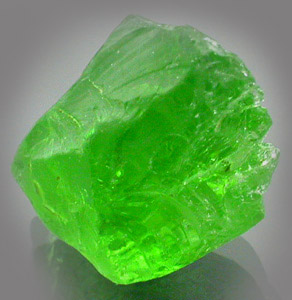Peridot: The Healer's Stone
- Details
- Written by CrystalWind.ca
- Views: 28152
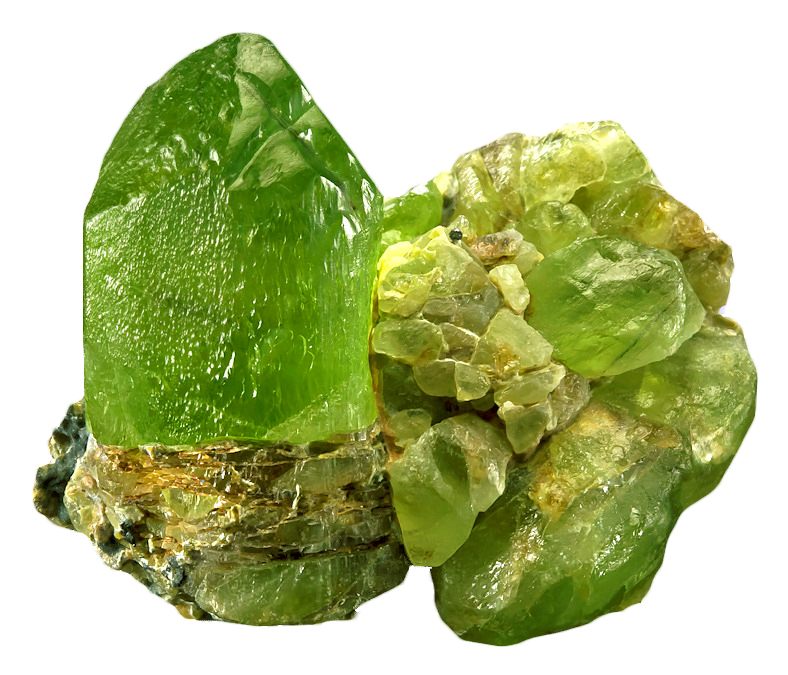
Peridot has been used as a Power Stone for centuries. Peridot fosters emotional balance, and helps us heal from past emotional wounds.
It clears the pathway to the heart and heals damaged egos. Anger, jealousy, bitterness, and irritation are usually a result from wounded hearts (and sometimes, a wounded EGO). Peridot helps us move past the hurt, and understand our relationships. It adds intelligence to our romantic situations, giving us a bit of common sense in affairs of the heart, and protecting us from unnecessary heartache.
Peridot is a particularly good stone for “healing the healers”. Peridot helps people who work in the healing field by cleansing their auras and releasing and neutralizing toxins on all levels. Peridot purifies the subtle bodies and mind. It opens, cleanses and activates the heart and solar plexus chakra.
A Visionary stone, it brings understanding of destiny and purpose. It releases negative vibrations, and promotes clarity and well being.
Peridot is purported to have the ability to bring healing and vitality to the whole body. It is said to increase patience, confidence and assertiveness. Stories have been told since ancient times about how this gemstone has the ability to slow the aging process.
Physical Healing Properties:
As with other gemstones, the color of the peridot stone is directly related to parts of the body that it can be of aid to.
- Because of its yellowish green color, peridot has been believed to cure diseases of the liver and difficulties with digestion.
- It aids in physical detoxification and helps problems with the kidneys, bladder, gall bladder, and the stomach.
- Peridot heals such illnesses as ulcers, constipation, and irritable bowel syndrome.
- It is also useful in helping to heal insect bites.
- Peridot has a tonic effect - it heals and regenerates tissues, strengthens the metabolism and benefits the skin.
- It aids the heart, thymus, lungs, and spleen.
- If placed on the abdomen, it aids in giving birth by strengthening the muscle contractions while lessening the pain.
- Peridot is also helpful in treating skin diseases and difficulties associated with the adrenal glands and endocrine systems.
- It is used to treat fevers.
- Used by Egyptians, Aztecs, and Incas to gently cleanse and heal the physical heart (lungs, lymph, breast), spleen, intestinal tract, and strengthen eyes in cases of astigmatism and nearsightedness.
Metaphysical Properties:
Peridot is a powerful cleanser:
- It releases and neutralizes toxins on all levels.
- It alleviates jealousy, resentment, spite, bitterness, irritation, hatred and greed.
- Peridot reduces stress, anger and guilt.
- Peridot (Chrysolite) opens our heart to joy and new relationships.
- It enhances confidence and assertion, motivating growth and change.
- Sharpens and opens the mind to new levels of awareness.
- Banishes lethargy, apathy and exhaustion.
- Peridot enables you to take responsibility for your own life.
Peridot opens, cleanses and activates the heart, which can help one to release old baggage. All burdens, guilt and obsessions become cleared and a new psychological clarity and feeling of well-being begin. Peridot teaches that holding onto the past is counter-productive. It shows you how to detach yourself from outside influences and how to look to your own higher energies for guidance. It assists in moving forward rapidly in therapeutic situations. It also helps you understand your destiny and spiritual purpose, helping you attain your full potential. All in all, the stone sharpens the mind and opens it to new levels of awareness.
Peridot is wonderful at helping one to release the old and embrace the new. It can assist one in realizing the detrimental patterns in one’s life and can be the basis of attaining that which is necessary for growth. Only spiritual or clear-minded persons should use Peridot. The person with too many earthly problems will not be able to understand the beauty of the Peridot. The very spiritual can wear Peridot in a necklace with the stone at the base of the throat to feel its soothing effect.
The Stone of Emotional Healing
Commonly used in treating emotional states such as anger or jealousy and irritation. It's color as well as the stone, inspires healing, renewal, purification, rebirth and growth. It has the power to heal hurt feelings and mend damaged relationships.
- Jealousy: Particularly good in helping to deal with jealousy, a very dark destructive emotion. Peridot was worn by the ancient Egyptian high priest to guard against jealousy of the Pharaoh's power.
- Happiness: Being a "Sun" energy stone due to its yellow-green color, makes Peridot a warm, friendly, happy stone.
- Stress-reliever (anxiety): More powerful when set in yellow gold. More effective when pierced, as in a bead form.
- Calming: Promotes sleep
Anger is an emotion peridot has been known to be very beneficial for. The stone calms the nervous system, helping to dissolve emotional tensions and bring balance to the system. It actually attracts love and calms raging anger from within. It alleviates jealousy, resentment, and spite, and reduces stress.
The peridot stone can be extremely beneficial to those who are having self-esteem problems. The stone enhances confidence and assertion without aggression. It helps a person see their own light and recognize that they are deserving of love. It assists in looking back to the past at negative experiences, and shows a person how to forgive himself. Peridot helps deal with guilt, whether it is self-imposed, or the product of others manipulative ways. It can help you to admit your mistakes and move on, taking responsibility for your own life, especially when you believe it is all someone else’s fault. It also helps those who feel they have little personal power as working with the stone or keeping one with you will give you that extra boost you might need. It is stimulating to one’s energy level, promoting vitality both physiologically and psychologically. It is invigorating and rejuvenating, promoting access to ones inner vision and joy.
Psychological Healer
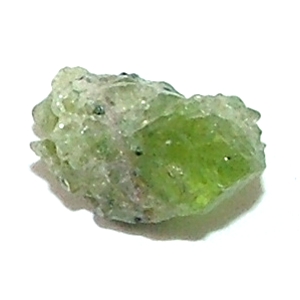 Peridot is also very beneficial when it comes to treating psychological afflictions as well. It is a wonderful stone to help someone who is going through depression. It is a stone of lightness that counters the effects of negative emotions. It has the ability to balance the process of emotional release and detoxifies negative emotions, bringing them to comfortable levels. Peridot fosters emotional balance, security, and inner peace.
Peridot is also very beneficial when it comes to treating psychological afflictions as well. It is a wonderful stone to help someone who is going through depression. It is a stone of lightness that counters the effects of negative emotions. It has the ability to balance the process of emotional release and detoxifies negative emotions, bringing them to comfortable levels. Peridot fosters emotional balance, security, and inner peace.
It soothes nervousness, heals emotional and physical pain, and lightens suffering. Such usages date back to ancient Roman times when rings of peridot were worn to relieve depression. Because it is calming to the nervous system, peridot is also useful in promoting sleep. Peridot banishes lethargy, which can attack someone who is experiencing depression.
The stone’s energy balances bipolar disorders and other forms of depression and helps one’s self esteem or bruised ego. It also brings about necessary change, which is much needed to someone who is depressed.
Peridot also has other psychological effects and uses. It can help one overcome hypochondria. It can greatly improve difficult relationships. It treats phobias, particularly those associated with fears of the dark, becoming like a security blanket to a small child. Peridot represents wealth and financial success (think of its green hue) and also attracts romance.
Peridot Associations:
 Chakras: Solar Plexus Chakra, Heart Chakra.
Chakras: Solar Plexus Chakra, Heart Chakra.- Clears 4th, Heart Chakra pathway, strengthening breath of life, prosperity, growth and openness. Peridot when used to cleanse and to stimulate the 4th, Heart Chakra and 3rd, Solar Plexus Chakra, brings openness and acceptance to the intellectual pursuit in matters of love and relationships.
- For specific chakra work though, because it acts to seal the aura, it is suggested that peridot be removed while working on chakras other than the heart and solar plexus.
- Birthstone: August
- Zodiac: Gemini, Leo, Virgo, Scorpio, Sagittarius
- Planet Associations: Mercury, Venus and the Sun
- Typical colours: Olive green, bottle green, yellowish-green, lime green. One of the few gemstones sometimes found in meteorites. Lime is a cleansing color, so it helps clean out any accumulated toxins. This relates to food, diet, and toxins associated with drugs, smoking and alcohol. Green signifies a good luck stone.
- Too much lime around you, and you can become unbalanced,
- Too little and we may feel hateful and envious. ( green with envy?)
- Vibrates to the numbers: 5, 6, and 7
- Angelic: The Archangel Raphael is the Archangel for those in need of healing, wholeness, and unity and he is affiliated with the colors green and deep pink.
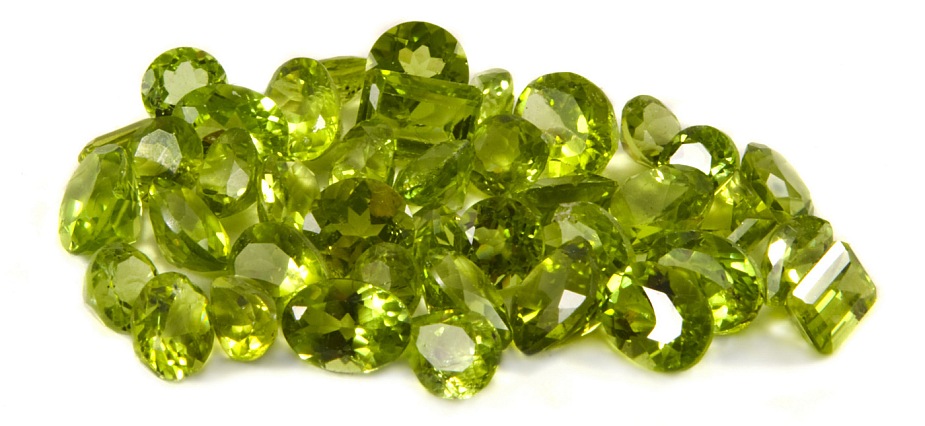
Magical Properties
- Energy: Receptive
- Element: Earth
- Associated Metal: Gold
- Powers: Protection, wealth, health, sleep
Peridot is indeed a springtime gemstone, with its fresh springtime color, as it has the ability to project you into a new life cycle. If you seem to be stuck and not moving forward, use peridot along with a white and green candle.
Peridot is a typically green but sometimes it is also yellowish-green or olive green. It is opaque and when polished can be crystal clear. Peridot emits a warm and friendly energy helping one to release the old negative patterns one is accustomed to.
By aligning the subtle bodies and increasing the desire for personal growth, it can lead one to new doors of opportunity. Peridot can also help you discover your destiny or purpose in life. It opens one up to new challenges and adventures. It is also helpful in warding off evil spirits.
The joyful and friendly energy of this stone helps to make and seal friendships, it clears the heart, releases the ego, which in turn cleanses jealousy and anger, hence bringing about a sense of peace and quiet amusement.
To dream of peridot signifies that you need to be cautious for a period of time.
Lost Items: Can be used to bring results to a search - seeking and of lost or mislaid items, but applies to the spiritual realm as well, as in feeling despair, spiritually lost , or emotionally isolated,
Childbirth: Has been used to facilitate the birth process, stimulating contractions and opening the birth canal. Slip a piece into your "birth room" sack you are taking to the hospital.
Peridot is also a Money Stone. Wear it to draw money and opportunity your way. Put Peridot in your cash box along with Citrine. Peridot will help to draw money to you, and Citrine will help to keep it once you get it!
Peridot is a 16th Anniversary gemstone.
Peridot, also known as Chrysolite, is a variety of Olivine.<div style="clear: both;">
Careers:
Doctors, Nurses, Emergency Crew, Hospital workers, Dentist, Optometrist, Healing, Care Giver, Technicians, Veterinarians, Counsellors, Physicians, Ministers, Clergy, Mothers
Extra on Peridot:
12 Steps of Alcoholics Anonymous
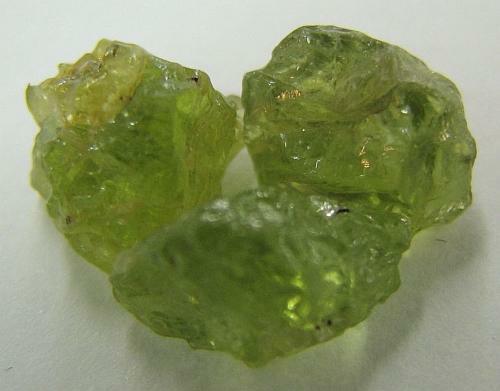
- Beginners Stone: Detoxing: Nice gift for someone in their first year. Processes, Releases and neutralizes toxins on all levels.
- 2nd Step Stone: A good first "Spiritual Stone" for people who have not yet had a spiritual awakening, or are having trouble relating to a "Higher Power" as it helps people who are having trouble relating to the reality of a world beyond the physical world.
- 8th Step Stone: Helps us deal with anger, jealousy, envy, and other strong emotions particularly in relationships with others, which might get in our way or "becoming willing" to make amends to those people. In healing these past hurts, and getting these strong emotions under control, we begin to see the part we played in any given situation on a more detached, intellectual level rather than an emotion level.
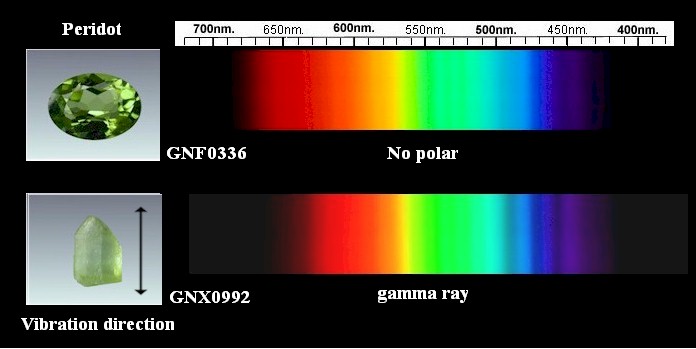
PHYSICAL PROPERTIES:
- Chemical composition: (MgFe)2SiO4
- Class: nesosilicate
- Crystal system: orthorhombic; 2/m2/m2/m
- Crystal habit: commonly as compact or granular masses, also as loose or embedded grains, sometimes in volcanic nodules. Crystals are rare, usually as vertically striated prisms.
- Twinning: twinning is uncommon, simple twinning can occur on {100}, {011}, and {012}. Cyclic twinning on {031} reportedly produces trillings.
- Specific gravity: 3.22 - 3.45, increases with iron content
- Index of refraction: 1.65 - 1.69, increases with iron content
- Birefringence: strong, (0.035 - 0.038)
- Pleochroism: weak; pale yellow-green to yellow/pale yellow-green to yellow/yellow to yellow orange
- Hardness: 6.5 to 7, hardness increases with magnesium content
- Color: olive green, green, yellow, brown
- Luster: vitreous to oily
- Transparency: transparent to translucent
- Cleavage: poor on {010} and {110}, {010} cleavage improves with increasing iron content
- Fracture: conchoidal
- Streak: colorless

OLIVINE (peridot) BACKGROUND INFORMATION
Peridot is a gemstone variety of forsterite, the magnesium-rich end of the olivine series. Chrysolite is a golden yellow variety of peridot. Peridot is ideochromatic, getting its distinct green coloration from ferrous iron which is a natural part of its crystal lattice structure. Higher quality peridot generally contains about 10 to 15% iron. The olivines are isomorphous (all have the same crystal structure), with varying chemical compositions. The most common of the olivines have chemical compositions in the complete solid solution series between pure forsterite (Mg2SiO4) and pure fayalite (Fe2SiO4). A less common solid solution series also exists between the olivine varieties fayalite (Fe2SiO4) and tephroite (Mn2SiO4). Another uncommon solid solution series exists between monticellite (CaMgSiO4) and kirschteinite (CaFeSiO4). The naturally occurring pure calcium chemical end member larnite (Ca2SiO4) does not have the olivine structure.
The green color of peridot, the gem variety of olivine, is mainly dependent on the amount of ferrous iron present, this color then being modified by trace amounts of Fe3+, Ti4+ and Ni2+. The better green colors occur with a Fe:Mg ratio of about 1:8. Higher concentrations of Fe result in less desirable yellow-green or brownish green shades. Pure brown peridots are rarer. Peridot gems have a hardness of about 6.5, which makes them very suitable for use as gemstones in earrings, brooches and pendants. Their use as ringstones requires some extra care to prevent abrasion and loss of polish.
Peridot (also called Chrysolite) is a stone with a sparkling pale green color. It occurs in lime, yellowish green, olive green or medium dark green hues. Chemically composed of Magnesium iron silicate [Mg,Fe] 2SiO4; Peridot (precious olivine) is a gem-quality transparent green olivine. The crystals of peridot have a vitreous lustre and conchoidal fracture. Gem-quality olivine is a mineral that composes a lot of the earth's mantle, the layer below the crust. It is also common in basalts on the moon.
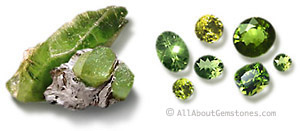
OCCURRENCE AND DIAGNOSTIC FEATURES
Peridot (olivine) commonly crystallizes very early in the crystallizing sequence of mafic and ultra-mafic igneous rocks at relatively high temperatures. These early formed crystals can settle by gravity forming dunite, a rock composed essentially of olivine, or the rock known as peridotite which also contains pyroxene with occasional accessories hornblende, ilmenite, garnet, hematite or chromite. Olivine is a common constituent of gabbros and basalts. Still molten underground basalts, in which early formed peridot grains have settled to the bottom by gravity, are occasionally ejected during volcanic eruptions, and the masses of peridot grains are thrown out as volcanic bombs. Peridot is also found as glassy grains in stony meteorites. Mg-rich olivines form by thermal metamorphism of dolomitic limestones. Fe-rich olivines are less common, occurring in alkali rocks. Fayalite (Fe2SiO4) has been found in gas cavities in volcanic rocks and glasses.
Peridot is usually distinguished by its color, luster and conchoidal fracture. The refractive index and specific gravity of peridot are higher than in tourmaline, and lower than in chrysoberyl, zircon and garnet. Sinhalite has a higher specific gravity and more pronounced pleochrism. Glass and moldavite are isotropic.
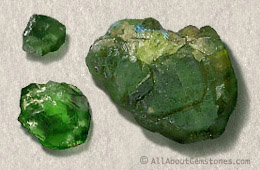
HISTORICAL INFORMATION AND USES
The name olivine is from the latin oliva in reference to the mineral's color. Peridot is from a thirteenth century English word peridote.
From ancient times until the eighteenth century, peridot was referred to as 'topazion' or 'topaz', most likely because it was found on the island of Topazios (known today as Zebirget or Isle of St. John in Egypt) in the Red Sea. In the eighteenth century the name topaz was given to our mineral topaz of today, and gem olivine became known as peridot. Yellowish peridot also has been commonly referred to as chrysolite which is from Greek meaning yellow stone. The term chrysolite has also been commonly used in referring to greenish-yellow gem chrysoberyl.
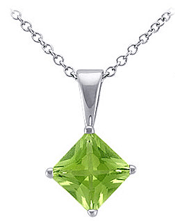 Peridot is used as a gemstone. Mg-rich olivine is used in refractory sand and brick in the casting industry because of its high melting point.
Peridot is used as a gemstone. Mg-rich olivine is used in refractory sand and brick in the casting industry because of its high melting point.
At one time, Peridot was more valuable than diamonds. This gemstone is actually known by three names: Peridot, Chrysolith and Olivin, because peridot is the gemstone variety of the olivin mineral. In the gemstone trade it is generally called peridot, a name derived from the Greek word "peridona", with a meaning along the lines of "giving plenty".
Peridot is one of the few gemstones which exist only in one color. Finest traces of iron account for the deep green color with a slight golden hue. Chemically Peridot is just an iron-magnesium-silicate, and the intensity of color depends on the amount of iron contained. The color as such can come in any variation from yellow-green and olive to brownish green. Peridot is not especially hard – it only achieves about 6.5 to 7 on the Mohs´ scale – and yet it is easy to care for and quite robust.
The name "peridot" (péridot French, peridoto Spanish or Italian), means "golden stone" in Greek (peridona); and is also derived from the French word "peritot," meaning "unclear" due to significant amounts of inclusions that are typical in the stone. Golden-yellow peridot also goes by the name "chrysolite."
Peridot, also known as the "evening emerald," was treasured by the Egyptian Pharaohs, and some of Cleopatra's "emeralds" were actually peridots. In the Middle Ages, people wore peridot to gain foresight and divine inspiration, as well as to protect them against evil.
PERIDOT MINING
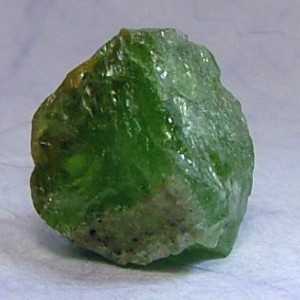 Peridot mining dates back some 4,000 years. Ancient olivine peridot mineral deposits located on St. John Island off the coast of Egypt in the Red Sea were documented by the Greek historian Pliny the Elder in his book Naturalis Historia (Natural History) in AD 70. Those ancient deposits on St. John Island, now named Zabargad Island still produce high-quality peridot stones, although most modern Peridot comes from the United States in Arizona. One of the largest faceted peridot gems in the world (Smithsonian Institution collection) is a 311.8 carat (62 g) stone found on Zabargad.
Peridot mining dates back some 4,000 years. Ancient olivine peridot mineral deposits located on St. John Island off the coast of Egypt in the Red Sea were documented by the Greek historian Pliny the Elder in his book Naturalis Historia (Natural History) in AD 70. Those ancient deposits on St. John Island, now named Zabargad Island still produce high-quality peridot stones, although most modern Peridot comes from the United States in Arizona. One of the largest faceted peridot gems in the world (Smithsonian Institution collection) is a 311.8 carat (62 g) stone found on Zabargad.
Peridot, also called precious olivine (magnesium iron silicate), is a transparent green variant of forsteritic olivine associated with peridotite, a dense mafic or ultramafic igneous rock. Peridot crystallizes in the orthorhombic crystal system, with a "granular mass" crystal habit, usually resulting in rounded pebbles; or in short, vertically-striated prisms. Peridot is classified as a Nesosilicate in the Silicate mineral group.
Olivine is a mineral that composes a lot of the earth's mantle, which is the layer just below the outer crust. Olivine is also common in basalts found on the moon. Peridot was called "Topazion" until the 18th century when the British renamed it Peridot. Today, the highest quality peridot is typically mined in Pakistan, and is called "Kashmir Peridot" or "Cashmir Peridot."
The most beautiful stones come from the Pakistan-Afghanistan border region. Peridot as gemstone does also exist in Myanmar, China, the USA, Africa and Australia. Stones from East Burma, today’s Myanmar, show a vivid green with fine silky inclusions. Peridot from the American state of Arizona, where it is quite popular in Native Indian jewelry, often shows a yellowish to golden brown shade.
Sources: Burma (Myanmar), Egypt, Norway, Pakistan, Saudi Arabia, Sri Lanka, USA (Arizona, Hawaii)
Transparent green olivine peridot and a Peridotite druzy encrustation embedded in a basalt matrix is commonly found in lava fields. Transparent olivine is usually found in arid climates such as Arizona, Egypt (Zabargad), Saudi Arabia and Pakistan (Suppatt district) due to its susceptibility to decay when subjected to weathering and rain.
PERIDOT TREATMENTS AND CARE
Peridot is not usually enhanced or heat-treated but it is occasionally treated with colorless oils, wax, and natural or synthetic resins to fill in voids or surface fractures, and to improve appearance or surface luster.
Peridot has a lower durability than many other gemstones, and when a faceted peridot is set in a ring with a prong setting extra care should be used. Peridot is also subject to thermal shock, therefore you should never clean peridot jewelry in an ultrasonic cleaner due to its tendency to fracture. Similarly, you should avoid the use of a steam cleaner as rapid changes in temperature may cause fracturing.
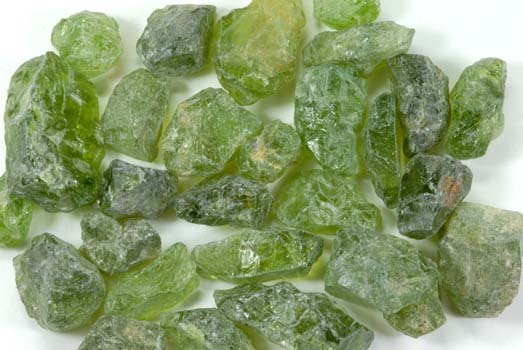
The Story of Peridot
A couple of thousand years ago BCE, on a full moon night, while sailing upon the Red Sea, sailors landed on a small Island of the Serpents. Under the bright moonlight they saw glowing crystals among the volcanic earth. At first light those crystals turn green glitters in the sand.
This is how humanity discovered Zabargad.
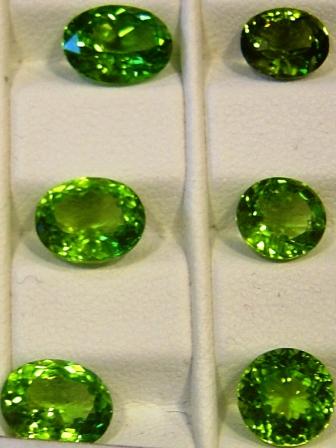
The Egyptian royalty in the capital city of Thebes fell quickly for the mysterious gem. In Naturalis Historia, Pliny tells of the first specimen presented to queen Berenice. (Theban queen of Lower Egypt, about 300 BCE). She was not the only one. Historians even suspect that at least some of the “emeralds” worn by Cleopatra were actually Peridots. According to Agatharchides in his De Mare Erthraeo, Egyptian kings ordered the discoverers to collect gems and deliver them to the royal gem cutters for polishing. Apart from fashion, Peridot was considered a symbol of the sun.
Soon enough the ancient Jews picked on this trend as well, named it “Pitdah” and used it in the fabled Breastplates of Aaron described in the Bible (Exodus 28, 15-30). The breastplate was a ceremonial religious garment set with twelve gemstones that represented the twelve tribes of Israel and corresponded with the twelve signs of the zodiac and the twelve months of the year.
Aaron, Berenice and Cleopatra are all but gone, but the largest cut Peridot, which weighs 310 carats is still on display in the Smithsonian, was found on Serpent Isle, later known as St. John Island.
During the Ottoman Empire (1300-1918) Turkish sultans amassed the world’s largest collection. They were competing with the Crusaders, returning home from their holy journeys with large Peridots as part of the loot. Fine gems from this era remain today in a number of European sanctuaries including the Treasury of the Three Magi in Cologne and the Vatican. The precious stones and jewelry collection in the Tower of London also contains large Peridot gems.
The source of the name Peridot is not very clear. It could be derived from the Greek “peridona”, meaning “giving plenty”, or from the Arabic word Faridat, although the current name in Arabic is Zabargad. To add up to confusion, the old Farsi name Zamroot means emerald which is Izmargad in ancient Hebrew. Later the stone was known as Topazion. Probably around the 18th century, the French were the first to call the yellowish-green stone Peridote, although the English have similar claim.
It was probably, regarding their history, more of a French name.
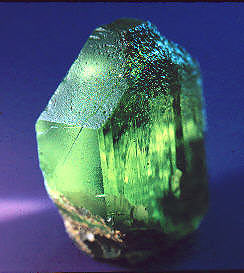
Peridot belongs to the forsterite-fayalite (most of the gem variety is predominantly foresterite, named after the German naturalist, John Forester) mineral series which is part of the Olivine group. It is one of the “idiochromatic” gems, meaning the color created by the basic chemical composition of the mineral itself, not from minor impurities, and therefore will only be found in shades of green.
Its chemical formula is given by: (Mg,Fe)2SiO4.
Peridot is found in many corners of the world and beyond, that is from meteorites. In Russia, a few cut Peridots were produced out of a meteorite which fell in 1749 in east Siberia. The most unusual olive green gem that comes from meteorites is called Pallasites. Moldavite is found in the Czech Republic and believed to have arrived from space in a meteor about 14.8 million years ago. Because this stone contains crystals of Olivine and has a similar color it is often confused with Peridot. Some of these extraterrestrial gems are very beautiful though and have been faceted and set into jewelry.
Because Peridot was created during volcanic action, occasionally, those green crystals are found on the black sands of Hawaii.
The United States was for many years the largest producer of this green material, and the value of production in 1993 was estimated at $1.5 million. Peridot Mesa, located on the San Carlos Apache Indian Reservation east of Globe in Gila County, is the most productive locality for Peridot in the world. Gem-quality Peridot can be found in deposits at three different locations in New Mexico. The deposits are in the Buell Park area in McKinley County in the northwestern part of the state and in Kilbourne Hole and Potrillo Mar depression.
Very large, super fine-quality Peridot gems are produced from deposits in Mogok area in Burma. These deposits were well known for their 20- to 80-carat cut stones of superb color and clarity, but since the “socialist” government came to power, supply dwindled and Burmese Peridot became all but rare collectors’ item.
In the early 1990s, the rough mountainsides of Nanga Parbat, stretching far west of the Himalayas, fine crystals in a deep and breathtakingly beautiful green were discovered. Unique stones of over 100 carats were found. Soon enough these stones have been termed “Cashmere Peridot”.
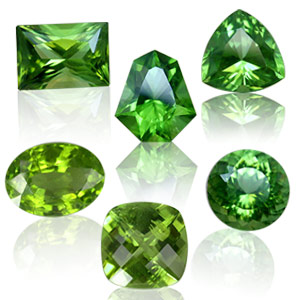
Since the late 90’s and early 2000, the bread and butter Peridot is being mined, cut and sold out of China. Although on the yellowish side and mostly in the 1 to 3 carats size range, with China’s untapped labor reserves and aggressive business tactics, Chinese Peridot has an excellent price point. It is clearly taking over the commercial slice in the global Peridot pie.
The ancient Romans were quite fond of the gemstone and coveted the brilliant green sparkle, which does not change in artificial light. They already named the stone “Evening Emerald”. Today, the airy, slightly golden bright green of Peridot could not escape the attention of contemporary designers in the jewellery and fashion industries. Its fine pistachio green or olive green goes perfectly with many summer collections. No wonder that Peridot is assigned to the summer month of August.
If you are still in doubt you should consider the reputation Peridot has at the New Age circles: Peridot protects against nervousness; helps alleviate spiritual fear; aids in healing hurt feelings & bruised egos; incurs strength & physical vitality; aligns subtle bodies; amplifies other vibrational energies & positive emotional outlook; helps liver & adrenal function. If you are married do not forget that Peridot is the anniversary gemstone for the 16th year of marriage. And above all it is supposed to bring the wearer success, peace, good luck, and most importantly, helps his or her dreams to become true.
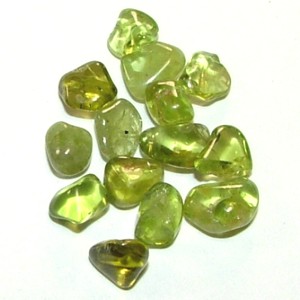
*Please note that all metaphysical or healing properties listed are collected from various sources. This information is offered as a service and not meant to treat medical conditions. Crystal Wind does not guarantee the validity of any of these statements.
©2010-2024 CrystalWind.ca. All rights reserved. Do Not Copy.
Liked this article? Dive deeper into personal growth and wellness! Check out CrystalWind.ca for spiritual wisdom or explore AromaWorx.ca for natural well-being tips. Spread the positivity—share this with friends on their happiness journey!
Let’s Chat! Drop Your Thoughts Below! ![]()
Latest Articles

Crystal Healing
Imagine a world of inspiration and healing, free for all—made possible by YOU!
Donate Now—Ignite the Magic at CrystalWind.ca!

Epilepsy - Finding A Cure
Your donation can make a difference!
Help us find a cure – donate now!
Crystals In Depth
Crystal Tools
Unlock Your Light: Join Lightworkers Worldwide on CrystalWind.ca!
Crystal Skulls
Follow Us!
Featured This Month
Watermelon Tourmaline
Synonym: Rainbow Tourmaline The watermelon tourmaline is a rare variety t... Read more
Virgo Mythology
The Virgo Myth In all of constellation mythology, few legends are as misund... Read more
Sun in Virgo
An Overview of Sun Sign Characteristics for Virgo Virgo is guided by Mercur... Read more
Sweet Violet
Sweet Violet Faithfulness and modesty. “I will always be true to you.” Helps... Read more
Peridot: The Healer's Stone
Peridot has been used as a Power Stone for centuries. Peridot fosters emotio... Read more
Mabon in Modern Times: Fresh Takes on the Au…
The Mabon season begins somewhere around the 21st-22nd of September and cont... Read more
The Vine: September 2nd - September 29th
The Autumnal Equinox ( Alban Elfed ) Celtic Symbol : The White Swan Read more
Crystals for Virgo
As the warmth of summer begins to soften into the crispness of autumn, the Sun... Read more
Mabon Magic: Ideas For Fall Decoration And R…
Welcome (almost!) to Fall! We’re turning the Great Wheel once again, toward ... Read more

